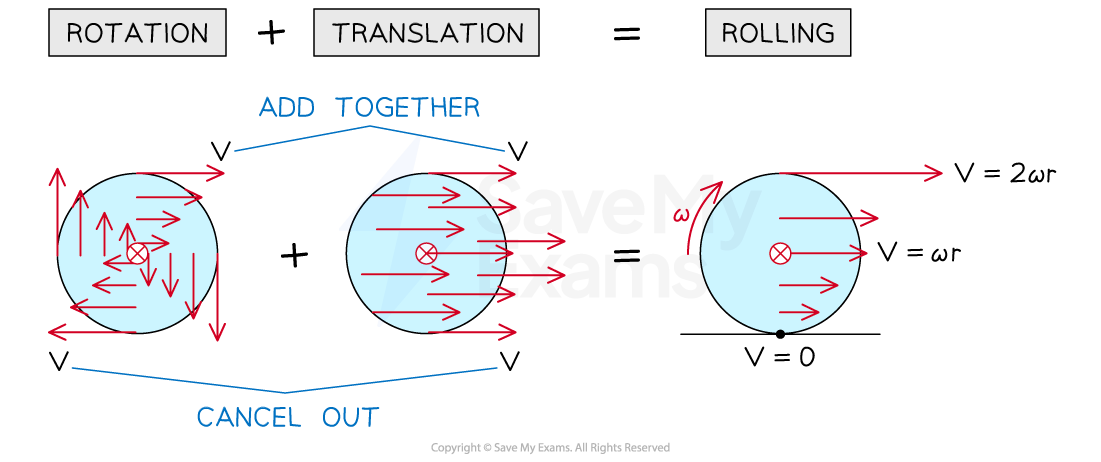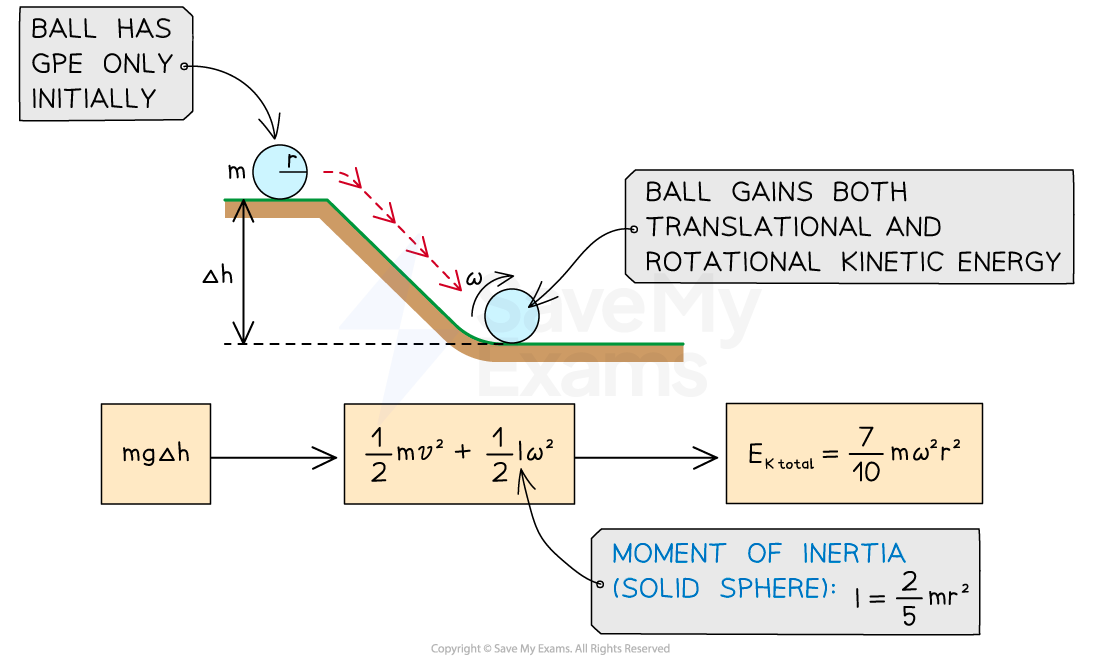Rotational Kinetic Energy (AQA A Level Physics): Revision Note
Exam code: 7408
Rotational Kinetic Energy
A body moving with linear velocity has an associated linear kinetic energy given by
Similarly, a rotating body with angular velocity has an associated rotational kinetic energy given by
Where:
= rotational kinetic energy (J)
= moment of inertia (kg m2)
= angular velocity (rad s−1)
= angular momentum (kg m2 s−1)
Rolling without slipping
Circular objects, such as wheels, are made to move with both linear and rotational motion
For example, the wheels of a car, or bicycle rotate causing it to move forward
Rolling motion without slipping is a combination of rotating and sliding (translational) motion
When a disc rotates:
Each point on the disc has a different linear velocity depending on its distance from the centre
The linear velocity is the same at all points on the circumference
When a disc slips, or slides:
There is not enough friction present to allow the object to roll
Each point on the object has the same linear velocity
The angular velocity is zero
So, when a disc rolls without slipping:
There is enough friction present to initiate rotational motion allowing the object to roll
The point in contact with the surface has a velocity of zero
The centre of mass has a velocity of
The top point has a velocity of
or

Rolling motion is a combination of rotational and translational motion. The resultant velocity at the bottom is zero and the resultant velocity at the top is 2v
Rolling down a slope
Another common scenario involving rotational and translational motion is an object (usually a ball or a disc) rolling down a slope
At the top of the slope, a stationary object will have gravitational potential energy equal to
As the object rolls down the slope, the gravitational potential energy will be transferred to both translational (linear) and rotational kinetic energy
At the bottom of the slope, the total kinetic energy of the object will be equal to

The GPE store of the ball is transferred to the translational and rotational kinetic energy store as it rolls down the slope
The linear or angular velocity can then be determined by
Equating
and
Using the equation for the moment of inertia of the object
Using the relationship between linear and angular velocity
For example, for a ball (a solid sphere) of mass m and radius r, its moment of inertia is
Equating the equations for
and
and simplifying gives
Worked Example
A student conducts an experiment to analyse the rotational motion of a turntable. The diagram shows the turntable with a small lump of gum held above it. An optical sensor connected to a data recorder measures the angular speed of the turntable.

The turntable has a mass of 550 g and a radius of 120 mm. It is made to rotate before rotating freely. The lump of gum is dropped from a small height above the turntable and sticks to it. The results from the experiment are as follows:
Mass of gum = 9.0 g
Distance of gum from the centre of the turntable = 117 mm
Angular speed of turntable immediately before gum is dropped = 3.28 rad s–1
The turntable is modelled as a solid disc with a moment of inertia
Calculate the change in rotational kinetic energy of the system immediately before the gum is dropped until immediately after it sticks to the turntable.
Answer:
Step 1: List the known quantities
Initial angular speed,
= 3.28 rad s–1
Mass of turntable,
= 550 g = 550 × 10−3 kg
Radius of turntable,
= 120 mm = 120 × 10−3 m
Mass of gum,
= 9.0 g = 9.0 × 10−3 kg
Distance of gum from the centre of the turntable,
= 117 mm = 117 × 10−3 m
Step 2: Calculate the moment of inertia of the system before and after the gum is dropped
Before the gum is dropped onto the turntable, only the turntable is rotating, so the initial moment of inertia of the system is due to the turntable only
When the gum is dropped onto the turntable, it can be modelled as a particle at a distance
from the centre of the turntable, with moment of inertia
So the final moment of inertia of the system is due to both the turntable and the gum
Step 3: Determine the kinetic energy of the system before the gum is dropped
The gum is initially at rest, so only the turntable has rotational kinetic energy initially
Step 4: Apply conservation of angular momentum to determine the final angular speed of the system
There is no net torque acting on the system, so the angular momentum of the system is conserved:
Step 5: Determine the kinetic energy of the system after the gum is dropped
The rotational kinetic energy of the system after the gum has stuck to the turntable is:
Step 6: Calculate the change in the kinetic energy of the system
The kinetic energy of the system decreases by
Examiner Tips and Tricks
Questions with a long calculation like the one in the worked example are best split into sections when putting them into your calculator. This makes it easier to check and type, ensuring the brackets are in the correct place. It is best to type it in exactly as you have it written down so it is input correctly.
The question asks for the change in rotational kinetic energy. This is found by calculating KE after − KE before. You should find that your answer is negative. This is because the gum sticks to the turntable, making it an inelastic collision in which the system's kinetic energy decreases.
Looking at the angular velocity before and after, when it is smaller, tells us that the rotational kinetic energy will also be less.

Unlock more, it's free!
Did this page help you?